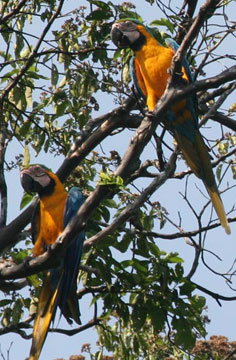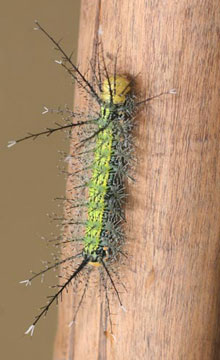Special to mongabay.com: Wilderness Classroom: Expedition 2006 The following is an update from The Wilderness Classroom’s expedition to the Peruvian rainforest. You can follow their adventures at wildernessclassroom.com |
Pacaya Samiria National Reserve: Macaws, monkeys, and…illegal loggers?
The Wilderness Classroom Organization
May 2, 2006
Update 11: Home sweet Hammock – Dave
Yesterday started out like a normal day. We swatted bugs, and slowly baked in the hot, equatorial sun. However, as the day progressed, large, dark clouds appeared on the horizon, and the trees top began to sway violently back and forth. Within seconds the sky let loose. It began raining so hard that it was difficult to tell where the river stopped and the air began.
The canoes began to fill with rainwater. Every half an hour we had to bail out the canoes to keep them from filling with water. The rain continued as we slowly made our way down river to towards a sacirita. A sacirita is a narrow waterway through the flooded forest, which cuts off a large loop in the main river channel. The sacirita that we were looking for would shorten our trip to the next ranger station by almost 15 miles.
A ranger at the last ranger station told us that we could find the sacirita by looking for a large Ponga tree on the side of the river near where we needed to enter the flooded forest. We spotted the Ponga tree, and turned down a narrow channel of water that rushed through the forest.
The channel was clogged with downed trees, and it was hard to follow the main channel. Several times we had to grab hold of vines and trees to keep our canoe from crashing into logs. Every time we tried a new side channel we were stopped by impassable log jams. Finally, we decided it was not safe to continue. We struggled against the current back to the main river channel, and found a small patch of dry land where we could camp for the night.
Relieved to be off the river we set up our hammocks, and started to cook dinner. After I hung up my hammock, my whole body started to itch and red blotches started to cover my skin . While we were in the flooded forest looking for the sacirita I had to hold onto a Cecropia tree covered in biting ants to keep our canoe from getting swept into a log. Five or six ants had bitten me on the neck and arms, and my body was not reacting well to the bites. I took some Benadryl, and crawled into my hammock to rest. The drugs caused the itching, redness, and swelling to subside, and made me very tired. As I drifted off to sleep a troop of Noisy Night Monkeys jumped through the canopy above my hammock.
 Macaws are usually found in pairs or larger flocks. Much like us, they are very social and prefer to travel with companions. |
The rainforest is full of Bullet Ants, spiders, snakes, and other poisonous critters that demand our respect. Our hammocks provide us with the shelter we need to get a good night’s rest. They keep us off the ground, safe from the insects, and protected from the rain. When I am at home I enjoy a nice soft bed, but in the rainforest, my hammock provides me with the perfect shelter.
Flying High! – Patrick
In Friday’s Daily Dilemma we asked for your suggestions about what to do when we are unable to camp on dry land. Several classes suggested that we take turns paddling until we find dry land. Others recommended hanging our hammocks in the trees above the water. We even received one suggestion to put our gear in our hammocks and sleep in the canoes!
Since we’re in pairs in the canoes, it could be difficult for one person to control the canoe while the other is sleeping. This option was tempting because it could allow us to paddle more hours every day. I think that hanging our hammocks in the trees above the water received the most support. Hanging up the hammocks could be kind of tricky, but once we’re up there, I’m sure we’ll all get a good night’s rest. Thanks for all of your clever ideas! Keep up the good work!
I’ve just known parrots as caged pets, so discovering them for the first time in their natural habitat has been strange and bewildering for me. The only previous experience I have had with Macaws is at the pet shop and at my grandma’s neighbor’s house in Florida. When visiting my grandma once, I investigated a loud noise coming from down the street. I found a beautiful Red-and-Green Macaw in the hand of a man who treated the bird like a child. I did not think birds made good pets but after seeing it on a leash, hearing it squawk at the dog, and watching the bird kiss the man, I realized that Macaws have quite the personality. Unfortunately, the bird he was keeping is an endangered species because of deforestation, loss of habitat, and the pet industry.
 Dave uses his hammock as a mobile office. He often works on updates from the comfort of his hammock. |
I am no longer surprised that people make parrots their pets, because they are very impressive creatures. Parrots are incredibly noisy, highly social seed and fruit eaters. Whenever we hear a little rustle in the trees and a plop-plop in the water below, it is usually a Blue-and-Yellow Macaw going after more fruits. These enormous birds can stand over three feet tall but remain out of sight in the trees overhead. We will inevitably hear them long before we see them appear. The macaws have the loudest voices of all 50 species of parrots in Peru.
Once in view, we marvel at the spectacular array of colors- scarlet, yellow, green and blue. Macaws use their hooked beak like a third foot to aid mobility. The bill has a hinge on its upper half that helps with handling food and climbing around in trees. Their feet have toes which are also highly adapted for gripping; if you have ever gotten too close to a Macaw’s cage, you may know what I mean.
Macaws, like most parrots, are usually found in flocks; often roosting with several other parrot species. During early morning, flocks of Macaws leave the roost, moving out to cover the forest in search of fruiting trees. They may travel more than 50 miles in a day!
We normally see Blue-and-Yellow Macaws flying slow and steady, usually in pairs. We have learned that macaws usually breed monogamously, meaning that pairing is often for life. We also read that their helpless offspring are nest-bound for 3 to 4 months. I wonder if it is husband and wife that we see flying the forest canopy together. Do you think it would help them to raise young together?
Macaws, monkeys, and…illegal loggers? – Anna
Fifty years ago, if you were to canoe through what is now the Pacaya Samiria National Reserve, trees like the cedar and the mahogany would have been a common sight. Today, those trees are few and far between, because of illegal logging. Since the Reserve was established in 1982, logging has been illegal in order to keep the cedar, mahogany, and other sought after trees plentiful. Unfortunately, loggers continue to cut valuable trees which are sold at a high price. On our trip through the Reserve, we have passed three groups of illegal loggers. These loggers use motor boats and chainsaws to go deep into the forest, and then, after cutting the trees, send huge barges of logs down the river to be sold overseas. The wood is primarily sold to build furniture. Not only are we losing the gift of seeing cedar and mahogany everywhere, animals like monkeys and birds are losing their homes.
 Caterpillars armed with poison tipped spines are just one of many animals that make us appreciate our hammocks. |
Illegal loggers are getting away with logging because there is nobody stopping them. Police do not patrol the Reserve, and because the loggers have guns and other weapons, the Park Rangers have no way of getting the loggers out of the reserve.
I wonder why the illegal loggers choose to do what they do. Maybe logging because they can’t find work anywhere else and need money for their family. Maybe they don’t care about trees. Maybe nobody has ever told them why it is important to preserve these beautiful trees.
Whatever the reason for the illegal logging, trees in the Amazon rainforest are disappearing rapidly. It is possible that in the next fifty years mahogany and cedar will be unheard of in the Pacaya Samiria National Reserve. Until the laws are more strictly enforced within the Reserve, loggers will continue to profit off the destruction of the rainforest.
I wonder what can be done where you live to stop the logging of trees in the Amazon Rainforest. I don’t know about you, but I am ready to take a stand for the trees. After all, don’t trees provide us with important things- like the air we breathe?
What should we do about the illegal loggers?
Like we said earlier, we have passed three groups of illegal loggers on our journey down the Pacaya River. We will probably pass several more throughout the Reserve. One group that we passed we didn’t see, but rather heard, as their loud chainsaws ripped through the trees. One group sped by us in huge dugout canoe motorboats. One group stopped by our camp last night looking for a place to sleep.
We feel very upset about the fact that these loggers are not only breaking the law, but they are destroying the rainforest, the home to thousands of plants, animals, and people. However approaching them might be dangerous. We want to stop them but we don’t know how.
Next time we come across illegal loggers, what should be do? Should we try to talk to them about how we feel? Should we yell at them and tell them that what they are doing is wrong? Should we wave and smile and continue on down the river? Should we completely ignore the loggers and pretend we don’t even see them? Should we report them to the park rangers?
We would love some suggestions from you on the best way to approach the illegal loggers. We look forward to hearing from you soon!
Track the adventurers at wildernessclassroom.com